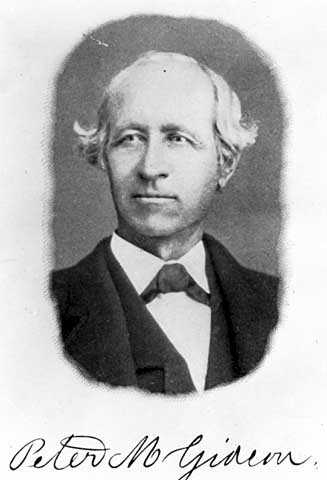Peter Gideon Farmhouse on:
[Wikipedia]
[Google]
[Amazon]
Peter Gideon (1820–1899) was a farmer near  In March 1878, Minnesota established a State Experimental Fruit Farm by act of the Legislature which Gideon ran for eleven years, planting many thousands of apple trees and distributing his best seeds across the state. The state farm was located near Gideon's land on Lake Minnetonka, under the jurisdiction of the University of Minnesota. When the farm closed in February 1889 due to conflicts with the University, Gideon lost his job. Gideon later became the first superintendent of a
In March 1878, Minnesota established a State Experimental Fruit Farm by act of the Legislature which Gideon ran for eleven years, planting many thousands of apple trees and distributing his best seeds across the state. The state farm was located near Gideon's land on Lake Minnetonka, under the jurisdiction of the University of Minnesota. When the farm closed in February 1889 due to conflicts with the University, Gideon lost his job. Gideon later became the first superintendent of a
Excelsior, Minnesota
Excelsior is a city in Hennepin County, Minnesota, United States. Excelsior's historic commercial district along Water Street is listed on the National Register of Historic Places, and the town has many Victorian-era houses. On Lake Minnetonka's ...
, United States, who was responsible for breeding apples that could withstand Minnesota's climate. Gideon's farmhouse, now within the boundaries of Shorewood, Minnesota
Shorewood is a city nestled in the woods along on the shores of Lake Minnetonka in Hennepin County, Minnesota, United States. The population was 7,307 at the 2010 census. The city was incorporated in 1956. Its area was originally part of the fo ...
, is listed on the National Register of Historic Places
The National Register of Historic Places (NRHP) is the United States federal government's official list of districts, sites, buildings, structures and objects deemed worthy of preservation for their historical significance or "great artistic v ...
.
Gideon moved to Minnesota in 1853, near Lake Minnetonka
Lake Minnetonka (Dakota: ''Mní iá Tháŋka'') is a lake located about west-southwest of Minneapolis, Minnesota. Lake Minnetonka has about 23 named bays and areas. The lake lies within Hennepin and Carver counties and is surrounded by 13 inc ...
, and experimented with planting pear, plum, cherry, peach, and apple seeds. After ten years of experimentation, the harsh Minnesota winters had killed off all of his trees except for one seedling crab apple
''Malus'' ( or ) is a genus of about 30–55 species of small deciduous trees or shrubs in the family Rosaceae, including the domesticated orchard apple, crab apples, wild apples, and rainberries.
The genus is native to the temperate zone of th ...
tree. Instead of giving up, he sent back to Bangor, Maine
Bangor ( ) is a city in the U.S. state of Maine and the county seat of Penobscot County. The city proper has a population of 31,753, making it the state's 3rd-largest settlement, behind Portland (68,408) and Lewiston (37,121).
Modern Bangor ...
for seeds and scions, and continued his experiments by grafting a scion onto the crab apple tree. From this experiment, in 1868 he successfully selected a variety of apple that he named the "Wealthy
Wealth is the abundance of valuable financial assets or physical possessions which can be converted into a form that can be used for transactions. This includes the core meaning as held in the originating Old English word , which is from an I ...
", in honor of his wife.
 In March 1878, Minnesota established a State Experimental Fruit Farm by act of the Legislature which Gideon ran for eleven years, planting many thousands of apple trees and distributing his best seeds across the state. The state farm was located near Gideon's land on Lake Minnetonka, under the jurisdiction of the University of Minnesota. When the farm closed in February 1889 due to conflicts with the University, Gideon lost his job. Gideon later became the first superintendent of a
In March 1878, Minnesota established a State Experimental Fruit Farm by act of the Legislature which Gideon ran for eleven years, planting many thousands of apple trees and distributing his best seeds across the state. The state farm was located near Gideon's land on Lake Minnetonka, under the jurisdiction of the University of Minnesota. When the farm closed in February 1889 due to conflicts with the University, Gideon lost his job. Gideon later became the first superintendent of a University of Minnesota
The University of Minnesota, formally the University of Minnesota, Twin Cities, (UMN Twin Cities, the U of M, or Minnesota) is a public university, public Land-grant university, land-grant research university in the Minneapolis–Saint Paul, Tw ...
agricultural experiment station established in 1878. The station was abandoned in 1889, when he retired, but in 1907 the Minnesota Legislature
The Minnesota Legislature is the bicameral legislature of the U.S. state of Minnesota consisting of two houses: the Senate and the House of Representatives. Senators are elected from 67 single-member districts. In order to account for decennia ...
established a fruit breeding farm between Excelsior and Chaska. The fruit breeding farm later became the Horticultural Research Center, which is now part of the Minnesota Landscape Arboretum
The Minnesota Landscape Arboretum is a horticultural garden and arboretum located about west of Chanhassen, Minnesota at 3675 Arboretum Drive, Chaska, Minnesota. It is part of the Department of Horticultural Science in the College of Food, Agric ...
. The center later developed the Haralson apple, introduced in 1922. The Wealthy apple is genetically related to the Haralson, though it took DNA testing to rediscover this fact after extensive hybridization.
See also
* John S. Harris (horticulturalist)References
{{DEFAULTSORT:Gideon, Peter, Farmhouse Colonial Revival architecture in Minnesota Houses in Hennepin County, Minnesota Houses on the National Register of Historic Places in Minnesota National Register of Historic Places in Hennepin County, Minnesota